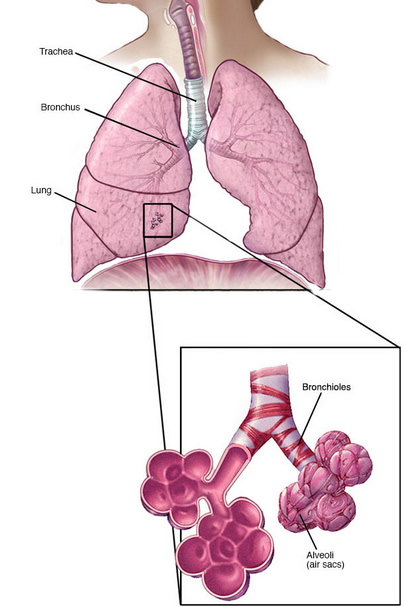Both emphysema and bronchiectasis can significantly interfere with the lungs function, making it more difficult to breathe. Even in severe cases, they could be life-threatening. Some treatments are available. The treatment plan is highly variable, depending on several factors. A challenging question, are they reversible?
Emphysema
Emphysema, one of main types of COPD (chronic obstructive pulmonary disease), is quite common in some countries – including in North America and UK. This respiratory disease involves the enlargement of alveoli (air sacs) in the lung.
What are alveoli? Bronchi (main airways in the lungs) branch off into smaller passageways, and the smallest ones are called bronchioles. And at the end of each bronchiole, you have very tiny air sac called alveolus (the plural of alveolus is alveoli). See the following picture, image credit to Mayo!
Alveoli are essential part of the lung where oxygen begins to enter to the circulation (bloodstream) and carbon dioxide go away from the bloodstream.
In emphysema, the alveoli become enlarged due to the breakdown and damage of their walls. Over time, the air sacs lose their normal shape (there will be larger air sacs instead of tiny ones).
More damaged airs sacs means there’s a decreased surface area for gas exchange. As a result, you can have difficulty to catch your breath and get adequate oxygen for your body needs.
Shortness of breath is the main symptom, and it usually develops gradually. Even you may not notice any symptom for many years until the damaged alveoli becomes advanced. Feeling of breathlessness usually gets worse during exertion such as during exercise. But in severe case, it may also occur even while you’re at rest.
Emphysema is a progressive condition that will significantly ruin the lungs function over time, especially if the disease is poorly controlled and not treated as well. In most patients with COPD, emphysema is quite common to be found together with chronic obstructive bronchitis (a condition in which the linings of the airways thicken due to irritation and inflammation).
Excessive exposure to tobacco smoke (including for secondhand smoke) is the main risk factor of emphysema. If you smoke, quitting as soon as possible can help a lot to reduce your risk of developing the disease. If you’re already diagnosed with the disease, quitting can also plays a part to control and prevent it from getting worse.
Other risk factors include exposure to other air irritants (such as air pollutions), respiratory infections, age (the risk increases with age), and genetic factors.
Bronchiectasis
It is a chronic condition in which the walls of bronchi (the main, large airways of the lungs) get thickened and abnormally widened.
Symptoms
Persistent cough (difficult to improve) that comes up with a large amount of phlegm is the most common symptom. Sometimes there is only a mild phlegm (with a small amounts of phlegm), or none at all. But in general, the symptom will be more noticeable as bronchiectasis progresses and becomes advanced.
The color of phlegm can vary, too. It can be yellow-greenish, pale yellow, or colorless (clear). In some cases, the cough may come up with phlegm containing blood (blood-stained phlegm), depending on the severity of the disease.
Shortness of breath is another common symptom. People with bronchiectasis can have exacerbations (periodic flare-ups of difficulties in breathing). Other symptoms may include wheezing, joint pain, chest pain, and clubbing of the fingertips.
If the infection develops, the symptoms will worsen within a few days. You can cough up more phlegm which may smell more unpleasant, and your breathlessness worsens even more. The infection may also be followed with fatigue (tiredness), general feeling of sick, coughing blood, or sharp pain in the chest (especially when breathing).
Causes
Bronchiectasis starts to develop when the muscles and tissues surrounding the bronchi are destroyed or damaged. There are a number of causes why this may occur:
- In some cases, the problem begins to develop in childhood after having a severe lung infection such as whooping cough and pneumonia, especially if the infection has damaged the main airways of the lungs.
- Cystic fibrosis, a disorder that typically occurs in children and young adults. It can causes sticky, thick mucus in the lungs and other parts of the body.
- If something goes awry with the body immune system that causes the main airways of the lungs to become more vulnerable to get damaged from an infection.
- ABPA, allergic bronchopulmonary aspergillosis. It is a disorder in which you have excessive allergic reaction to particular type of fungi that may make the main airways of your lungs to easily get inflamed when you inhale spores from the fungi.
- Genetic conditions such as immunodeficiency syndromes and primary ciliary dyskinesia.
Sometimes the cause is unidentifiable. If the cause is not known, this is called idiopathic bronchiectasis.
Are emphysema and bronchiectasis reversible?
Both respiratory diseases could be life-threatening, because they can lead to serious damage in the lungs. The bad news, the damage can be permanent. Does this mean that they cannot be cured and irreversible?





